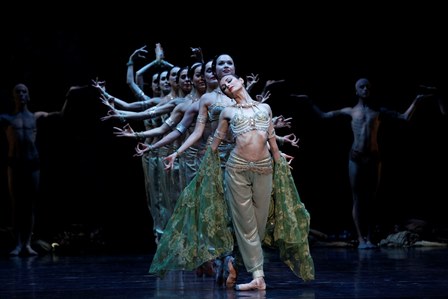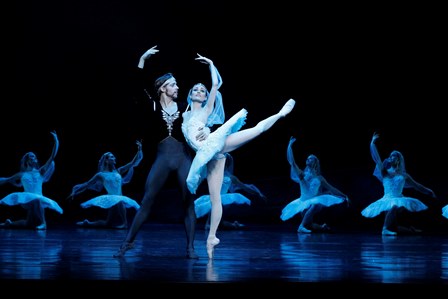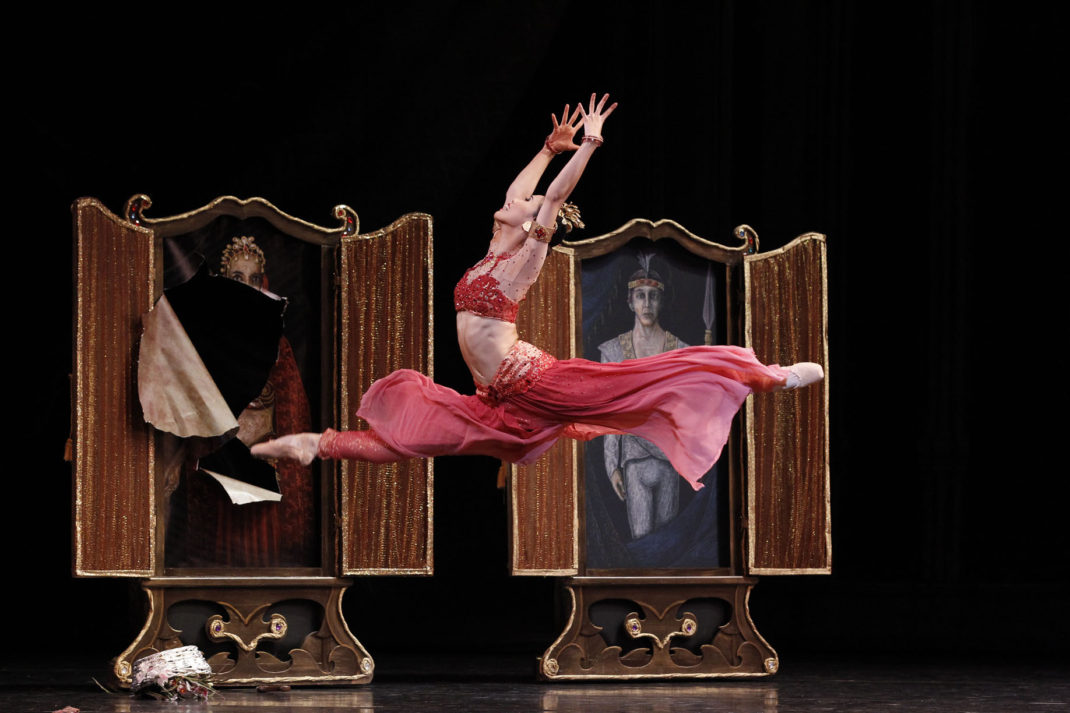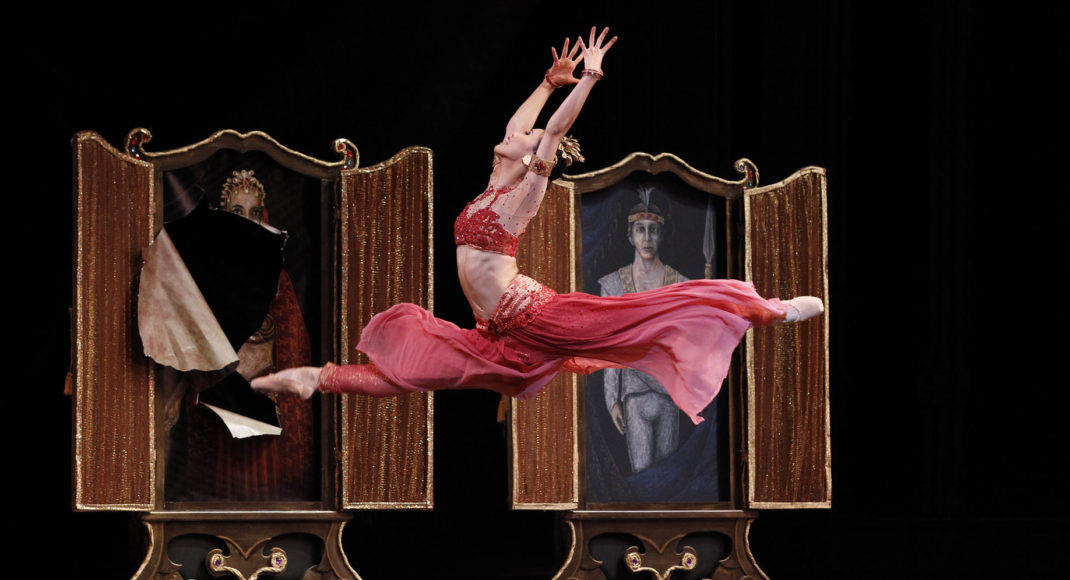29 August (evening) and 30 August (matinee), 2014. State Theatre, Victorian Arts Centre, Melbourne
Stanton Welch made his new version of La Bayadère for Houston Ballet, of which he has been artistic director for ten years. Its premiere was in 2010. He has now restaged it for the Australian Ballet, where he still holds the position of resident choreographer.
It was always going to be a problematic ballet: an updated version of a work that is entrenched in nineteenth-century cultural values where countries beyond Europe were regarded as little more than examples of exotica, and were represented as such in the theatre. Choreographically, Welch’s Bayadère makes passing references to traditional Indian greetings and hand movements from forms of Indian dance. There are also plenty of attitudes (the ballet step) with angular elbows and hands bent at the wrist, palms facing upwards. They remind us of a dancing Shiva. But there is also a lot of waltzing at certain points and the mixture doesn’t ring true today. So much of what we can accept from a production that claims to look back to the original (Makarova’s production for example), we can’t accept from a new production made in the twenty-first century. It all becomes a frustrating jumble.
So too with the costuming. There are no tutus (thankfully) until the Kingdom of the Shades scene, although there is a confusion of costuming, especially with Solor who is dressed like a balletic prince in tights and jacket while everyone else has a costume that approximates an Indian-style outfit.

My enjoyment of the work depended very much on the casting. The first show I saw, with Lana Jones as Nikiya and Adam Bull as Solor, was a lack-lustre performance, which only highlighted the feeling that the work was a cultural and choreographic jumble. While Jones’ first solo was beautifully danced—she has such a fluid upper body—she and Bull were not connecting and it seemed like a very sullen pairing. Robyn Hendricks as Gamzatti, whose villainous nature Welch has strengthened nicely, overplayed the role somewhat and didn’t look good in that harem costume, which reveals the rib cage rather dramatically.
In that first viewing, I loved the two children who accompanied Solor’s mother wherever she appeared. They were an absolute delight and took an active interest in everything happening on stage. And Vivenne Wong executed the first solo in the Shades scene with precision and attack—those relevés on pointe down the diagonal were spectacular.
In a second viewing I had the pleasure of seeing Amber Scott as Nikiya and Ty King-Wall as Solor. My interest in the work soared.

King-Wall and Scott danced beautifully together and their various pas de deux were silky smooth and imbued with tenderness. This was the first time I have seen King-Wall in a principal role since he was promoted and he certainly lived up to that promotion, both technically and in terms of successfully entering a role and developing a partnership. Ako Kondo as Gamzatti once again danced with superb technical skill. Perhaps she was a little too nice for the role in its new guise, but she engaged well with Laura Tong as Ajah, her servant, and it is impossible not to be swept away by her superb dancing.
The issue of Indian references aside, Welch’s choreography is always interesting to watch. I have written elsewhere that I think his best works are abstract rather than story ballets and I enjoyed watching how he structured scenes for larger numbers of people in Bayadère. His choreography for the Rajah’s four guards was simply constructed but often surprising in the way each came forward for a mini solo. And later, during the wedding celebrations for Solor and Gamzatti, Welch handled a bevy of guards and guests easily and maintained interest, despite the waltzing, in each of the different groups throughout that sequence of dancing.
Design-wise, Peter Farmer’s chaise-longue, on which Solor reclined to smoke his opium before the shades of Nikiya began their procession down the ramp, was gorgeous. Its luscious curves gave it an art nouveau feel and its back reminded me of the underside of a mushroom, magic mushrooms no doubt.
This production of La Bayadère is full of melodrama, a ‘cat fight’ between Nikiya, Gamzatti and Ajah; people being killed left right and centre; appearances by men in gold paint; and temples tumbling into ruins. But Petipa’s choreography has been maintained in certain places and, with a good cast, the story speeds along and much can be forgiven.
Michelle Potter, 2 September 2014
Featured image: Ako Kondo as Gamzatti in Stanton Welch’s La Bayadère. The Australian Ballet, 2014. Photo: © Jeff Busby.


In the cold light of morning and after my third viewing, I can’t decide whether Stanton has renovated or trashed “La Bayadere’. In the renovation corner is the speedy, clear storytelling and, in the Betrothal Scene, the nicely integrated divertissements. However I do miss tutus in this scene for the Grand Pas. [Stanton’s decision to abandon tutus for the Fairies variations in his AB “Sleeping Beauty” was a similar issue for me]. His decision to make more work for the male dancers, especially in the second scene in Act 1 and in the Betrothal Scene, and to make the High Brahmin a dancing role, is also commendable. The no-holds-barred approach to characterisation is also quite arresting. However it all seems to be at a cartoonish level and the “oriental” hand movements and poses look like something from a Ruth St Denis spectacle in the 1920’s. In fact a strong aroma of high camp thoroughly pervades things. The giving over to the men some of the suavest salon melodies in the score [the number normally danced by women with scarves attached to wrists and ankles in Scene 2 and the number given to the women with parrots in the Betrothal scene] results in a strangely epicene feeling.
But as Stanton gives us a “straight” Shades scene, and we have casting such as Gaudiello/Eastoe and guests Badenes/Camargo, all falls into place as it should in La Bayadere and I was quite overwhelmed by how much emotion those 2 casts pulled out of that scene, especially Gaudiello. I was not so happy with the Bull/Jones pairing. Whilst they look magnificent together in terms of their shapes and proportions, Lana Jones seems, at this stage and for me, unable to expressively phrase her movements. As Gamzatti she took my breath away with her spectacular Betrothal scene, but her Nikiya was not at all moving. The Gamzatti of Hendricks was, once again, camp of a very high order -impossibly glamorous and silken, sinuous movements. However this approach doesn’t work in the final scene where Gamzatti is given a mournful solo. Kondo was able to suggest a human with regretful feelings under all the cartoonish villainy. The various shades solos haven’t played out too well in my performances, especially the third variation.
I was never bored during the performances [unlike, at certain sections, during the Paris Opera and previous Makarova AB productions] however I feel Stanton has produced a slightly “dumbed-down” version. I am due to see a Scott/King-Wall performance on Friday and am looking forward to see how Scott does things.
Thanks for your response Adrian. It is good to keep the discussion going. Re the three solos in the Shades scene, yes I agree that the third solo was not well done (at least not in the two shows I saw). It became very static I thought and even though the steps are often ‘placed’ rather than liquid ones there is no excuse for making the whole thing look jerky.
The ‘orientalism’ reminded me of Welch’s approach in Butterfly and attempting to recreate the movement vocabulary of others (Indian, Japanese or whatever) never works. The world has moved on and I think ballet needs to do the same. I suspect we should relegate the full-length Bayadère to the archives and retain only the Shades scene. Or else it needs the touch of a genius. Kylian managed to create Kaguyahime and not fall into the trap of trying to be quasi-oriental.